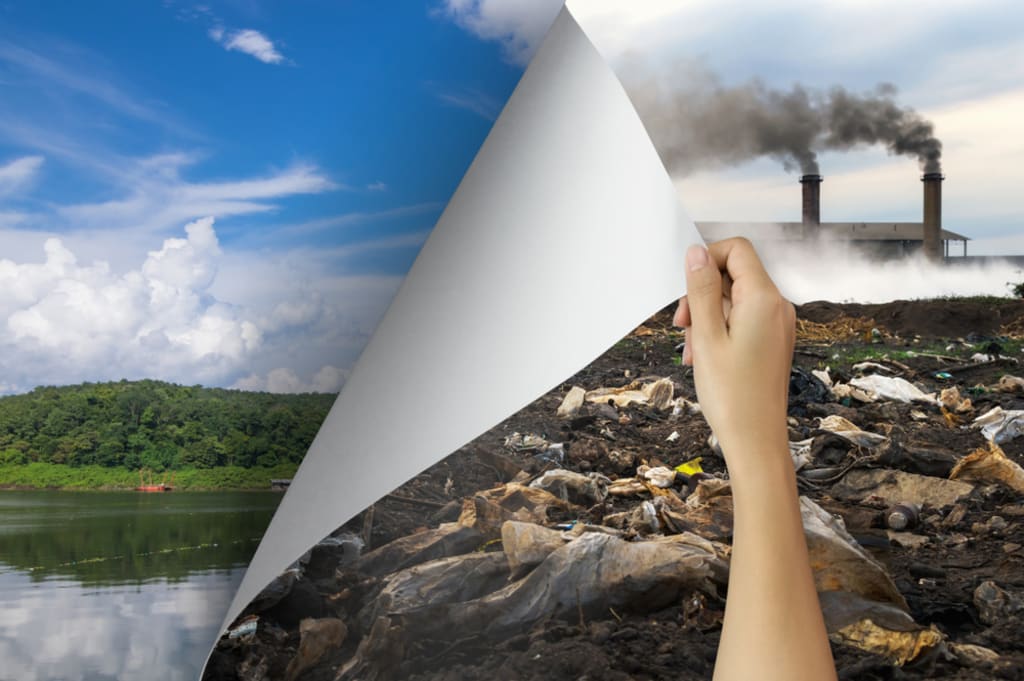Take a Seat
Why Small Actions Can't Sustain the Future

A prevailing conviction exists that reducing the carbon-footprint of an individual can substantially mitigate the effects of climate forcing emissions. And while it may hold merit if worldwide adoption of these behaviors were achieved, it fundamentally disregards the reticent mind of individuals and the commanding forces that inform decisions. I would like to challenge this belief and present what I think is a more effective way to save our oceans.
All anthropogenic greenhouse gasses (GHG) emerge from our need of energy; therefore, to deduce the best measures for combating climate change, it’s important to first assess our relationship with energy. To simplify this analysis, we’ll reduce the scope by targeting the country which emits the greatest amount of CO2 per year.
According to the International Energy Agency (IEA), in 2018, China and the United States emitted 28% (10 GT) and 15% (5 GT) of the world’s CO2 emissions, respectively. The combined output amounts to almost half of the global CO2 emissions. However, when adjusted for population, the US emissions per capita ranked 4th place in a list of top 20 emitters compiled by the Union of Concerned Scientists. China ranked 13.
Next question, how do US emissions look when divided by economic sector? According to the Environmental Protection Agency (EPA), the residential sector, in 2018, is responsible for emissions of about 0.38 GT of CO2 equivalent. In contrast, the combined output from transportation, electricity generation, and industry is just above 5 GT. Does that number seem familiar? It’s the same number quoted by the IEA for total US emissions! In other words, eliminating CO2 emissions at home won’t even dent the overall figure and it won’t save our oceans, so feel free to turn on your heaters in proportion to the depths of your pockets.
Based on the statistics, the most we can do is drive less. But how many of us can afford that? And how are we going to convince a culture so deeply enraptured by automobiles? We could work around it by purchasing electric vehicles, but fossil fuel combustion is still the dominant means of generating electricity, emitting 1.6 GT in 2019. Even if we could invent a zero-carbon vehicle in this decade, the inconvenient truth is that people can’t be changed -and a consequence of that freedom is living with the choices made by others regardless of how it affects you.
As the old proverb says, “you can lead a horse to water, but you can’t make it drink”. Granted, the horse will drink eventually, but in our case, it might be too late. So, we can buy reusable bags, eat less meat, avoid plastic straws, ride a bike, and consume carbon-neutral goods -but you’re still at the mercy of the masses. No matter what, there is an equal and opposite force negating everything you do. (Thanks, Newton.)
Next question, how do we influence people? To understand and predict human behavior, we must first study what drives us.
In her article, “The drivers of human behavior”, Denise McNally explains that we’re all connected by our propensity to seek happiness, and avoid pain and suffering. She listed six essential needs:
- Certainty (safety/control/consistency)
- Variety (adventure, challenge)
- Significance (meaning/importance)
- Love and Connection (communication/approval/connection)
- Growth (emotional/spiritual/physical development)
- Contribution (give/serve others)
What she didn’t mention is that some of these needs have a stronger pull than others. In my opinion, significance, connection, growth, and contribution are all associative values. They mean something different to everyone. On the other hand, certainty and safety are immutable values that, in a world with perceived scarcity, are only achieved by securing resources in the future. And what do we use to project resources into the future? Currency. The masses are driven by the invisible hand of Mr. Market.
My point: climate change solutions must balance the needs of the individual with equal weight to the needs of the Earth. Policies that reduce CO2 emissions at the expense of the individual will fail -especially if said policies rely on the conformity of the masses. Successful emission mitigating solutions will be affordable, accessible, and passive. If these metrics are met, even climate change critics will hop aboard. Until then, there is nothing we can do to change the behavior of 7.6 billion people. (And if we could, who deserves to wield that power?)
Now, I know things seem bleak at this point and you probably think we’re doomed, but there is a light at the end of the tunnel! Don’t believe me? You don’t have to! There are countries that have successfully reduced their CO2 emissions. Sweden, for example, reduced their emissions by 33% from 1990 to 2018. Their energy transformation, as reported by the IEA, was achieved through market-based policies that focus on energy efficiency and renewable energy.
Raymond Pierrehumbert, a physics professor at the University of Oxford, breaks it down for us in his paper, “How to decarbonize? Look to Sweden”:
- Carbon Tax. One of the world’s first carbon taxes were implemented in 1991 by Sweden at a rate of $110 per ton, which increased to $500 per ton in recent years. Industrial energy was taxed at half the standard rate to disincentivize companies from deserting to another country.
- Carbon-Neutral Buildings. Extensive investments in building energy efficiency and a district heating grid are the key ingredients for transforming Sweden’s residential and commercial energy sectors, which are composed of almost entirely carbon-neutral sources.
- Renewable Energy. Heat is supplied to the district heating grid from various sources (of which biofuels make up 70%) including the combustion of non-recyclable garbage, waste heat from server farms, passenger body heat in the central railway station, and geothermal heat storage systems. 40% of their low-carbon electricity is generated by nuclear power, which is being phased out as wind energy lays claim to a larger percentage of the energy mix. Did I mention hydropower yet? Biofuel? Yeah...
Hopefully your coffee’s a little sweeter now, but there is a slight caveat. Even if all anthropogenic GHG emissions in the world stopped today, the Earth wouldn’t stop warming until after 2033. Emitted CO2 remains in the atmosphere between 300 to 1,000 years, and 50% are absorbed by our largest carbon sink... the ocean. Considering the impracticality of enforcing zero-carbon emissions in the near future and its standing presence in the atmosphere, if we want to save our food chain from ocean acidification and take an active role in reducing the concentration of CO2 in our natural reservoirs, then we need to invest in carbon-capture technology.
Okay, so what can you do? We’ve seen that reducing an individual’s carbon-footprint is a fruitless effort because the residential sector makes up less than 7% of total US emissions. And because we can’t control the masses, focusing your time and energy on a restrictive lifestyle while hoping it will somehow inspire a cacophony of cultures with roots greater than your lifespan to adopt your behaviors (breathe), will most likely distract you from more effective alternatives and lull you into a false sense of security.
In the end, the best thing an individual can do to save humanity is to take a seat. After all, the greatest breakthroughs in human history happened while sitting down. (Heck, I’m sitting down right now!) And they occurred because of people like you. They occurred because someone opened a book, turned on their computer, and researched. Learn about the issues and their intricacies and inform your friends about what you discovered -not to influence them, but to empower them and encourage decentralized thinktanks. Humanity needs forward thinking individuals to design and lead the future.
In conclusion, as a parting gift to my reader, I would like to offer you a tall glass of cold water. I understand if you choose not to drink it but promise me you won’t let it go to waste. Promise me you’ll pass it on to someone else. I can only hope it may quench their thirst:
- Dive deep and research climate change.
- Research renewable energy.
- Research carbon-capture technology.
- Enter a Vocal competition about the environment.
- Start a thinktank amongst your friends.
- Work from home.
- Contact your representatives.
- Design something.
- Start a nonprofit.
- Start a carbon-neutral business.
- Run for political office.
And take a seat.






Comments
There are no comments for this story
Be the first to respond and start the conversation.